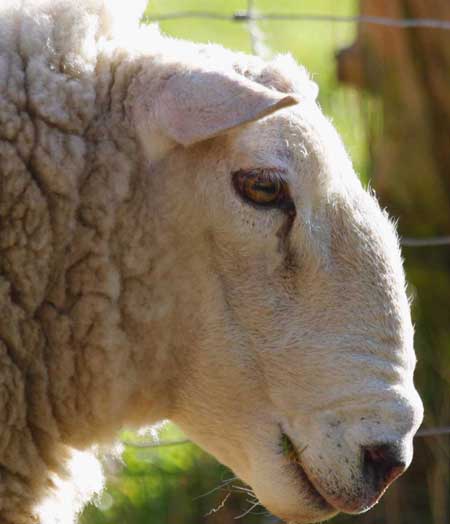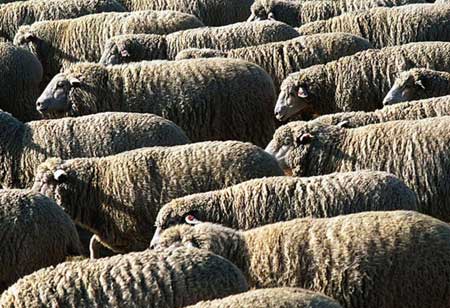by D. Van Metre 1 (5/2010)
Quick Facts…
- Entertoxemia is a frequently severe disease of sheep and goats of all ages.
- Causative bacteria are present in relatively low numbers and appear to be in a relatively quiescent state in the normal, healthy animal.
- Treatment may not be successful in severe cases.
- Prevention of enterotoxemia is far more likely to be successful than trying to treat the disease.
Enterotoxemia is a frequently severe disease of sheep and goats of all ages. It is caused by two strains of bacteria called Clostridium perfringens – the strains are termed types C and D. These bacteria are normally found in low numbers in the gastrointestinal tract of all sheep and goats. If that is so, when and why do they cause disease?
These organisms are normally “laying low” in the small and large intestine – that is, they are present in relatively low numbers and appear to be in a relatively quiescent state in the normal, healthy animal. What appears to trigger them to cause disease is a change in the diet of the animal. Most commonly, the change that triggers disease is an increase in the amount of grain, protein supplement, milk or milk replacer (for lambs and kids), and/or grass that the sheep or goat is ingesting. Collectively, these feeds are rich in starch, sugar, and/or protein. When
 |
unusually high levels of these nutrients reach the intestine, Clostridium perfringens undergoes explosive growth, increasing its numbers rapidly within the intestine. As the organism grows in number, it releases very potent toxins (bacterial poisons) that harm the animal. These toxins can cause damage to the intestine as well as numerous other organs. This can result in fatalities, particularly in the non-vaccinated animal or in the newborn lamb or kid whose dam has not been vaccinated.
The signs of enterotoxemia in sheep and goats include:
• The animals may abruptly go off of feed and become lethargic.
• Affected animals may show signs of stomach pain, such as kicking at their belly, repeatedly laying down and getting up, laying on their sides, panting, and crying out.
• Diarrhea may develop; in some cases, there is blood visible in the loose stool.
• Animals may lose the ability to stand, lay on their sides, and extend their legs, with their head and neck extended back over their withers.
This posture is caused by the effects of the toxins on the brain. Death
commonly occurs within minutes to hours after this sign is seen.
• Because enterotoxemia can progress so quickly, animals may be found dead with no previous signs of disease.
Treatment
Treatment of enterotoxemia may not be successful in severe cases. Many veterinarians treat mild cases with analgesics, probiotics (gels or pastes with “good bacteria), oral electrolyte solutions, and antisera, which is a solution of concentrated antibodies that neutralize the toxins that these bacteria produce. More severe cases may require intravenous fluids, antibiotic therapy, and other types of supportive care, such as supplemental oxygen.
Prevention
Prevention of enterotoxemia is far more likely to be successful than trying to treat the disease.
Vaccination
Vaccination is the cornerstone to prevention of this disease. For sheep and goats, there are multiple vaccines available that induce immunity to the toxins generated by Clostridium perfringens types C and D. Because tetanus is also an important disease to prevent in sheep and goats, many veterinarians recommend that sheep and goats be vaccinated with a vaccine that also induces protection against tetanus. These vaccines are often termed “three-way” vaccines because they induce protection against the three bacteria involved: Clostridium
 |
perfringens type C (enterotoxemia), type D (enterotoxemia) and Clostridium tetani (the bacterium that causes tetanus). Adult sheep and goats: When initiating vaccination for a given sheep or goat, all enterotoxemia/tetanus vaccines require two doses to induce effective immunity. These doses are usually administered 10 to14 days apart. Once each adult sheep or goat has received these two doses, repeat vaccination should occur at least once per year. Many veterinarians recommend that ewes and does be vaccinated roughly one to two months ahead of the anticipated birthing date, in order to maximize the amount of antibody present in the colostrum (first milk) – this helps to protect the neonate against enterotoxemia. If immunization of pregnant animals during that time frame is not feasible for you, then vaccinating the ewes and does at other times of the year appears to be effective.
For juvenile and adult sheep or goats fed diets rich in grain or allowed to graze lush pasture, more frequent vaccination for enterotoxemia may be warranted; some producers immunize these higher-risk animals two to four times per year to achieve adequate protection.
Keeping the mothers well-vaccinated is the best way to protect newborn animals against this disease, as the antibodies to the bacterial toxins are transferred to the newborns in the colostrum (first milk). Obviously, you need to ensure that newborns receive colostrum for this to work! Growing babies are typically vaccinated for the first time at six to 10 weeks of age, and one to two repeat (booster) vaccinations are typically given afterwards. Consult your veterinarian to determine what vaccination strategy best suits your operation and feeding program.
Feeding Strategies
Smart feeding strategies will also enable you to limit the potential for this disease to affect your herd or flock. Since the causative bacteria proliferate in the intestine in response to ingestion of abnormally high levels of starch, sugar, or protein, you need to be careful how you feed certain feedstuffs that contain high levels of these nutrients, such as grains, silage or haylage, lush pasture, milk or milk replacer, and protein supplements. Complete feeds – such as pellets designed to be fed to induce gain in lambs or kids – can also trigger this disease if fed in excess.
When feeding these high-risk feedstuffs, divide the daily allotment for each animal into as many small feedings as is feasible (say, three to four feedings), rather than providing such feeds in a single, large meal. It is also advisable to feed roughages such as hay before feeding these higher-risk feeds, simply to allow the animals to become full on hay beforehand. This helps to limit the potential for overeating on high-risk feedstuffs, such as grain. Consult your veterinarian to determine what feeding strategy is optimal for your situation.
Always make feed changes slowly. If you plan to increase the amount of grain fed to a flock or herd, always do so in gradual increments over several days. This helps the bacteria in the stomach to accommodate to the diet, making it less likely that the troublesome bacteria will get access to the nutrients. Make sure that you watch your animals for signs of dominance by one or more individuals – they can boss the others away from the grain and overeat; alternatively, the shy animals can hold back from feeding and become so hungry that they overeat. Divide your herd or flock as necessary, and make sure to provide an adequate number of feeding sites or feeder space to enable all animals an equal chance to eat.
For animals being turned out onto pasture after being fed hay or other stored feeds, a conservative thumb rule is to begin by allowing only about 10 minutes of grazing time on the first day. Double this with each subsequent day – it will take about a week for them to work up to a full 24 hours on pasture.
Heavily milking dams may need to be fed more roughage and less concentrate to limit the excessive milk production that might endanger their offspring. Keep the feed schedule consistent to lactating does and ewes to limit fluctuations in milk volume for their nursing offspring.
1 D. Van Metre, DVM, DACVIM, Colorado State University Extension specialist (veterinarian) and associate professor, College of Veterinary Medicine and Biomedical Sciences, Clinical Sciences. (5/2010).
Colorado State University, U.S. Department of Agriculture and Colorado
counties cooperating. Extension programs are available to
all without discrimination. No endorsement of products mentioned is intended
nor is criticism implied of products not mentioned.





